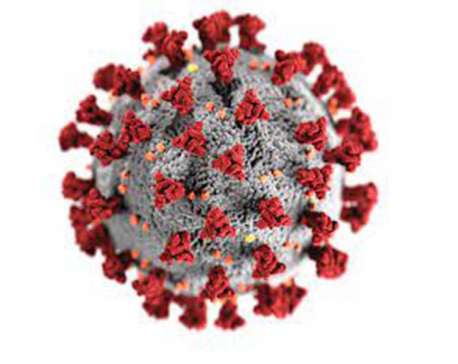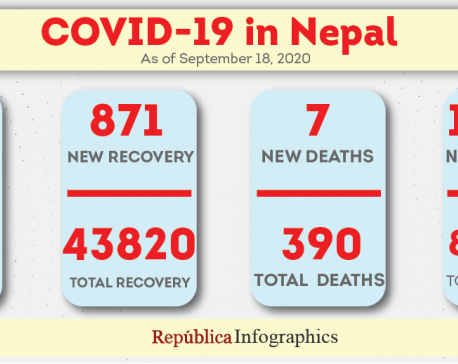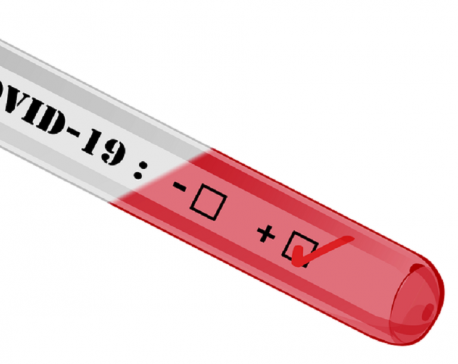
OR
#Children and COVID-19
How safe are children in Nepal where risk of a third wave of COVID-19 remains?
Published On: November 5, 2021 09:00 AM NPT By: Sangay Sherpa
_20211104175452.jpg)
KATHMANDU, Nov 4: Nepal has recorded over 814K cases of COVID-19 since the outbreak of the pandemic in March 2020. With over 11,400 deaths from the deadly virus in a span of 23 months, people of all age groups have adapted to the new normal, following the virus outbreak.
Earlier, the health ministry had warned people of a third wave of the pandemic hitting the nation in July, following the rise of COVID-19 cases at an alarming rate. The third wave was said to be more virulent and fatal for young children.
In Nepal, as many as 50,887 children between the age of 0-20 were infected by the COVID-19 from April to October 31, according to the information released by the Ministry of Health and Population (MoHP). Of them, 12,813 children were between the ages of 0-10, while 38,074 were between the ages of 11-20. Prior to that, as many as 24,503 children of those age groups were affected by COVID-19 across Nepal. So far, over 75,000 children have been affected by COVID-19.
Although the cases of children contracting the virus have increased, there have not been many cases of fatality among them compared to adults and senior citizens, experts say.
“Senior citizens were mainly affected in the first wave of COVID-19, while the second wave affected the youths. There was also news of the possibility of a third wave affecting young children. Despite the virus being transmitted among young children, the cases of fatality among those below the age of 20 have been very low compared to young adults and senior citizens in the world,” said Dr Sher Bahadur Pun, a virologist at Sukraraj Tropical and Infectious Disease Hospital. “However, with the virus continuously mutating and being present in society, nothing can be said about the future, regarding anyone’s safety from the virus,” Dr Pun added.
Similarly, Dr Pooja Amatya of Patan Hospital said that children who were infected by COVID-19 showed only mild symptoms and were not affected critically. “Children infected by COVID-19 were not critically affected by the deadly virus but showed mild symptoms,” Dr Amatya said. However, stating that the health infrastructures across the country are very weak, she said that the PCUs and HDUs need to be established across the country to minimize the mortality cases among children if a third wave breaks out.
In addition, the delay in the vaccination rollouts among young children has been alleged to undermine the health safety of children. With a weak health infrastructure and lack of medical equipment and manpower, the consequence of a third wave would be tragic, experts say. “In the case of a third wave, it would be very difficult to control the virus and save lives, considering the state of health infrastructure inside the country,'' Dr Pun said.
According to Dr Amatya, they have conducted virtual classes, physical training, and awareness programs to further strengthen the health infrastructure and manpower. “There is a lack of skilled manpower, pediatricians, and medical equipment if a third wave hits the country. We have conducted virtual classes and physical training in various parts of the country in coordination with the health ministry in hope of strengthening the health infrastructure,” Dr Amatya said.
Nepal is also celebrating Tihar- the second largest festival of Hindus. Large movements of people with their children can be seen in the markets around the capital. Citing the lower risk of COVID-19, schools, sports centers, cinemas, and malls among other public places have been reopened. While some schools and colleges have remained open, others are set to reopen following the end of Tihar. Samata School of Lalitpur has been conducting physical classes of grades eight, nine, and ten only, citing the risk of COVID-19 among younger children of the school.
According to Ram Krishna Bhandari, Principal of Samata School, classes have been resumed for students of grades eight, nine, and ten only. While there are over 800 students in the school, the classes of younger children have not yet started due to the omnipresent risk of COVID-19 on younger students. “We have been conducting the classes of senior students under the ‘one bench, one student’ rule, but we have decided not to conduct the classes of younger students,” Bhandari said. He added that it is still unsure if the classes will resume after the Tihar holidays, citing the risk of the virus.
Similarly, Samriddhi School has decided to restart physical classes from November 17 by implementing safety protocols. According to Chandra Maharjan, +2 program director at the school, a disinfection tunnel has been installed for young students to pass through before entering and exiting the school premises. As for the senior students, sanitizers have been placed in the school for use. “We have a protocol to send our students for checkups in case they show any kind of symptoms. A separate classroom has also been designated for students who have mild symptoms,” Maharjan informed Republica.
Meanwhile, Dr Amatya said that safety protocols are not enough to prevent the virus from transmitting among younger children. On the contrary, young children are very prone to the virus despite the precautions and the safety protocols. “Despite the ‘safety protocols' to prevent transmission, the infection is likely to spread among young students,” she said.
According to the health ministry, the highest rate of infection among young children took place in densely-populated areas like Bhaktapur, Sunsari, Kaski, Kathmandu, Lalitpur, Chitwan, Rupandehi, Morang, Banke, and Jhapa, among other districts.
Stating that the transmission is likely to spread in young children in urban areas, Dr Amatya said that the responsibility of the guardians upon their children's health safety should be their top priority as a precaution against COVID-19. “As the urban areas are not well ventilated and are mostly crowded, there is a chance of the virus transmitting to children from adults as well. As the vaccination rollouts for children of young age groups have not been initiated at the moment, the risk of the virus transmitting to children is still present,” she said.
As many as 6,122 children between the age of 0-10 have been affected by COVID-19 in Kathmandu, 1,335 in Lalitpur, and 805 in Bhaktapur districts, according to the information by the health ministry. Likewise, Kathmandu has recorded 16,381 COVID-19 cases among children between 11-20 of age, Bhaktapur has 1,888, and Lalitpur 3,328.
You May Like This

Nepal records 867 new cases, 1,123 recoveries and nine deaths on Saturday
KATHMANDU, Oct 2: Nepal recorded 867 new cases of COVID-19 alongwith 1,123 recoveries and nine deaths on Saturday, according to... Read More...

Nepal records 2,000 plus COVID-19 cases for first time, taking the country’s tally to 61,593
KATHMANDU, Sept 18: Nepal recorded a record daily jump of 2,020 coronavirus infections on Friday, taking the country’s national COVID-19... Read More...

COVID-19 tally in Gandaki Province climbs to 37 with first five cases reported in Parbat
POKHARA, June 2: Parbat district has reported its first case of novel coronavirus disease. Five persons from the district were... Read More...











Just In
- Challenges Confronting the New Coalition
- NRB introduces cautiously flexible measures to address ongoing slowdown in various economic sectors
- Forced Covid-19 cremations: is it too late for redemption?
- NRB to provide collateral-free loans to foreign employment seekers
- NEB to publish Grade 12 results next week
- Body handover begins; Relatives remain dissatisfied with insurance, compensation amount
- NC defers its plan to join Koshi govt
- NRB to review microfinance loan interest rate







Leave A Comment